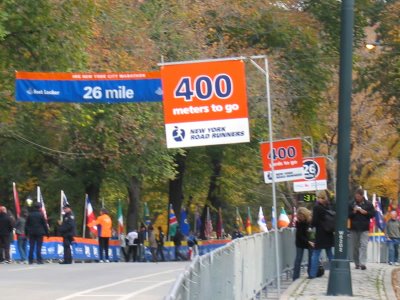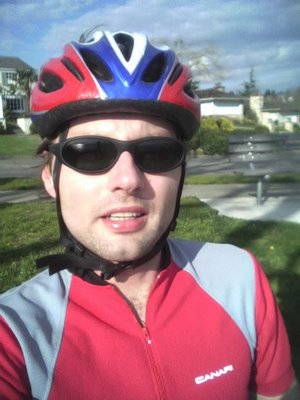How Not to Run a Marathon (no miracles)
 The key to a good performance is training; to an excellent one, severe training. My last training run was on October 13th, four weeks before the marathon. So I shouldn't have expected to do any better. But I did because the day before I did a 2 mile jog and I felt pretty good with no pain, and after a couple of miles after the marathon started I felt pretty good and instantly knew that I'd at least finish it.
The key to a good performance is training; to an excellent one, severe training. My last training run was on October 13th, four weeks before the marathon. So I shouldn't have expected to do any better. But I did because the day before I did a 2 mile jog and I felt pretty good with no pain, and after a couple of miles after the marathon started I felt pretty good and instantly knew that I'd at least finish it.Here's what happened. I got up at 5:45am EST, which was difficult to do when living on the West Coast. I was out of the hotel by 6:00 and made it to the 42nd St. & 6th Ave. bus stop only a few blocks away--I chose the hotel location with that in mind. According to the NYC Marathon guide, if you don't get to the bus stop by 6:30, you
 have to take the Staten Island Ferry from Battery Park. So, if you decide to stay in Manhattan during your stay, I suggest getting one very close to one of the two bus stops (according to the guide, "To ensure your on-time arrival at the marathon start, NYRR [New York Road Runners] recommends that you use our official marathon transportation... Private vehicles, including charter buses, are not guaranteed arrival in time for the race start.).
have to take the Staten Island Ferry from Battery Park. So, if you decide to stay in Manhattan during your stay, I suggest getting one very close to one of the two bus stops (according to the guide, "To ensure your on-time arrival at the marathon start, NYRR [New York Road Runners] recommends that you use our official marathon transportation... Private vehicles, including charter buses, are not guaranteed arrival in time for the race start.).I waited about 45 minutes to get on the bus. Then the bus took about an hour to get to the starting line staging area because the NYPD mismanaged the bus traffic flow near the Verrazzano Bridge. Just as the bus was crossing on the right side of
 the bridge, the disabled and wheel chair participants were starting on the left. It actually wasn't that big of a deal because the open field start wasn't until 10am! No kidding. I didn't read the marathon guide until I got to NYC--I previously thought it started at 8am or earlier, like most other marathons. So at the very minimum, you have to get up at least 4 hours before the starting time (unless you're disabled or a professional woman, in which case you could get up later because of an earlier start). That sucks, but to be fair, I don't see how the logistics could have been done differently with over 37,000 runners starting and the race being run through all of the five boroughs.
the bridge, the disabled and wheel chair participants were starting on the left. It actually wasn't that big of a deal because the open field start wasn't until 10am! No kidding. I didn't read the marathon guide until I got to NYC--I previously thought it started at 8am or earlier, like most other marathons. So at the very minimum, you have to get up at least 4 hours before the starting time (unless you're disabled or a professional woman, in which case you could get up later because of an earlier start). That sucks, but to be fair, I don't see how the logistics could have been done differently with over 37,000 runners starting and the race being run through all of the five boroughs.
At the staging area, there are 3 different sections. I was assigned to the green section. When I go there, my first goal was to get to a toilet. I only saw two sets of 5 toilets with about 50 people waiting in line for each. I waited about 15 minutes with almost no progress and then I overheard a guy who said there were many more toilets further down behind a building. Sure enough, they were there and my wait was only a few minutes. To be fair again, the location of the toilets is listed in the marathon guide, but not at the event, the latter I think being much more important. Overall, the organization was excellent. I especially liked the mile markers posted every mile with the time shown on each one, and of course all of the water stops--both were more frequent than the other marathons I was in.
There were no other glitches. I ate two bagels and an energy bar about an hour and a half before the start (breakfast provided at the start!). The rest of the time I was just sitting on the curb trying to stay warm. It was only about 40 degrees so I chose to wear tights, a t-shirt and a long-sleeve shirt (both dry-fit), and gloves and a hat. That choice of outfit served me well at the Seattle marathon last year so I decided to stick with it. It turned out to be OK even though most people wore shorts and t-shirts (many threw away their long-sleeve tops as they ran). It did warm up to about 50, but I was never hot.
 After the gun went off, it took me about 30 seconds to cross the starting line, so I was towards the front of the field (you have to line up based on your race number which is based on your estimate of your finish time). Even though we were on the lower deck of the bridge, I got a beautiful glimpse of the Manhattan skyline with two fire boats shooting off water in the foreground. I felt a little winded the first three miles or so. Afterwards I felt good and that's when I knew I'd finish the race, particularly because my Achilles tendon wasn't hurting at all. But maybe I felt too good because I thought I'd run a 3:15 or so.
After the gun went off, it took me about 30 seconds to cross the starting line, so I was towards the front of the field (you have to line up based on your race number which is based on your estimate of your finish time). Even though we were on the lower deck of the bridge, I got a beautiful glimpse of the Manhattan skyline with two fire boats shooting off water in the foreground. I felt a little winded the first three miles or so. Afterwards I felt good and that's when I knew I'd finish the race, particularly because my Achilles tendon wasn't hurting at all. But maybe I felt too good because I thought I'd run a 3:15 or so.After 5 miles or so, the crowds really started to pick up and there were people everywhere
 cheering and shouting. The vista wasn't that great--it was just 4 or 5 story brick tenements street after street, but I didn't care too much and was just focused on running. A couple of miles later, I saw a guy a few feet in front of me wipe out on the wet asphalt near a water stop. It looked like a very nasty fall; I don't know if he was able to finish.
cheering and shouting. The vista wasn't that great--it was just 4 or 5 story brick tenements street after street, but I didn't care too much and was just focused on running. A couple of miles later, I saw a guy a few feet in front of me wipe out on the wet asphalt near a water stop. It looked like a very nasty fall; I don't know if he was able to finish.At about this time, I was starting to get a blister on my right inner foot and I stopped twice to adjust my sock, but it didn't help. I got used to the discomfort and by the halfway point my joints and muscles were starting to hurt. This was the first time they started to hurt this early. I ran the first half at 1:36 so if I matched it I'd be at 3:12 at the finish. Not bad at all. But I knew that would be impossible. I was still hoping for 3:15. But the
 pain got worse and worse and by mile 18 I really started to slow down. The last 6 miles or so were really bad and I was stopping once or twice every mile to stretch, which only helped a little. By the way, my cardiovascular condition was fine, it was just the muscle and joint pain that slowed me down (the opposite of my last marathon). My body was not even remotely prepared to take that kind of a beating. Even today, four days after the race, I still can't walk straight (I think I'll be fine in a few more days). The good news is that my Achilles tendon didn't hurt and is going to be fine.
pain got worse and worse and by mile 18 I really started to slow down. The last 6 miles or so were really bad and I was stopping once or twice every mile to stretch, which only helped a little. By the way, my cardiovascular condition was fine, it was just the muscle and joint pain that slowed me down (the opposite of my last marathon). My body was not even remotely prepared to take that kind of a beating. Even today, four days after the race, I still can't walk straight (I think I'll be fine in a few more days). The good news is that my Achilles tendon didn't hurt and is going to be fine.So, I ended up finishing at 3:38. If it weren't for the crowds and all the other runners in the race,
 there is a very good chance I wouldn't have finished. Will I run it again? Right now, I'd say no, and not because of my finish time, but because I want to run in other cities and I don't like waiting that long for the race to start. Plus on the finance side, $300+/night for a 2-star hotel is a little too much.
there is a very good chance I wouldn't have finished. Will I run it again? Right now, I'd say no, and not because of my finish time, but because I want to run in other cities and I don't like waiting that long for the race to start. Plus on the finance side, $300+/night for a 2-star hotel is a little too much.BTW, these are pictures my girlfriend (thank you for the beer at the finish line and everything else :-) took near and at the finish line. The woman in the picture was not the top finisher (Jelena Prokopcucka from Latvia). The guy with the yellow shirt was the men's top finisher (Marilson Gomes dos Santos from Brazil) and the second man in the picture with two guys is Kenya's Paul Tergat, the marathon world-record holder.
Total: New York City Marathon (26.2mi Race; 3:38:xx)
P.S. Lance Armstrong finished at just under 3 hours. Good job Lance!

